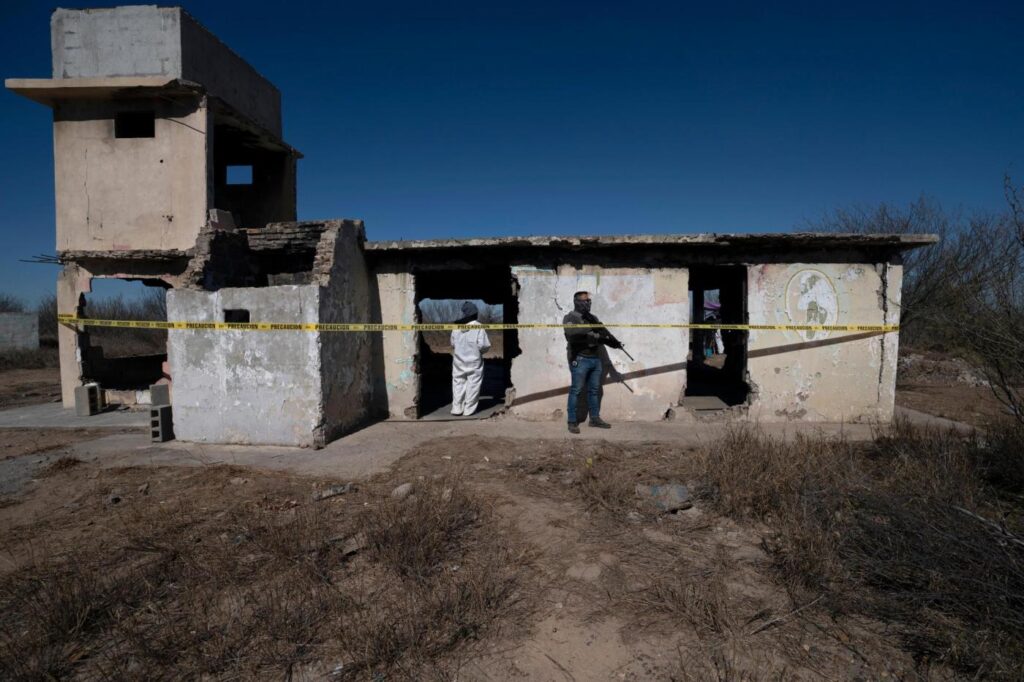
By MARÍA VERZA | Associated Press
For the investigators, the human foot — burned, but with some fabric still attached — was the tipoff: Until recently, this squat, ruined house was a place where bodies were ripped apart and incinerated, where the remains of some of Mexico’s missing multitudes were obliterated.
How many disappeared in this cartel “extermination site” on the outskirts of Nuevo Laredo, miles from the U.S. border? After six months of work, forensic technicians still don’t dare offer an estimate. In a single room, the compacted, burnt human remains and debris were nearly 2 feet deep.
At the site — to which The Associated Press was given access this month — the insufficiency of investigations into Mexico’s nearly 100,000 disappearances is painfully evident. There are 52,000 unidentified people in morgues and cemeteries, not counting places like this one, where the charred remains are measured only by weight.
And people continue to disappear. And more remains are found.
“We take care of one case and 10 more arrive,” said Oswaldo Salinas, head of the Tamaulipas state attorney general’s identification team.
Uncounted bone fragments were spread across 75,000 square feet of desert scrubland outside Nuevo Laredo. Twisted wires, apparently used to tie the victims, lie scattered amid the scrub.
Each day, technicians place what they find — bones, buttons, earrings, scraps of clothing — in paper bags labeled with their contents: “Zone E, Point 53, Quadrant I. Bone fragments exposed to fire.”
They are sent off to the forensic lab in the state capital Ciudad Victoria, where boxes of paper bags wait their turn along with others. They will wait a long time; there are not enough resources and too many fragments, too many missing, too many dead.
Meanwhile there is no progress in bringing the guilty to justice. According to recent data from Mexico’s federal auditor, of more than 1,600 investigations into disappearances by authorities or cartels opened by the attorney general’s office, none made it to the courts in 2020.
Still, the work goes on at Nuevo Laredo. If nothing else, there is the hope of helping even one family find closure, though that can take years.
That’s why a forensic technician smiled amid the devastation on a recent day: She had found an unburnt tooth, a treasure that might offer DNA to make an identification possible.
When Jorge Macías, head of the Tamaulipas state search commission, and his team first came to the Nuevo Laredo site, they had to clear brush and pick up human remains over the final 100 yards just to reach the house without destroying evidence. They found a barrel tossed in a trough, shovels and an axe with traces of blood on it. Gunfire echoed in the distance.
Nearly six months later, there are still more than 30,000 square feet of property to inspect and catalog.
The house has been cleared, but four blackened spaces used for cremation remain. In what was the bathroom, it took the technicians three weeks to carefully excavate the compacted mass of human remains, concrete and melted tires, said Salinas, who leads work at the site. Grease streaks the walls.
Macías found the Nuevo Laredo house last August when he was looking for more than 70 people who had disappeared in the first half of the year along a stretch of highway connecting Monterrey and Nuevo Laredo, the busiest trade crossing with the United States.
Most who disappeared here were truck drivers, cabbies, but also at least one family and various U.S. citizens. About a dozen have been found alive.
Last July, Karla Quintana, head of the National Search Commission, said the disappearances appeared to be related to a dispute between the Jalisco New Generation cartel, which was trying to enter the area, and the Northeast cartel, which wanted to keep them out. It’s not clear if the victims were smugglers of drugs or people, if some were abducted mistakenly or if the goal was simply to generate terror.
Related Articles
US ready to resume Mexico avocado exports
Avocado imports suspended from Mexico to US
For many asylum-seekers, flying to Mexico is ticket to US
Mexico vows to press on with power changes amid US concerns
The phenomenon of Mexico’s disappearances exploded in 2006 when the government declared war on the drug cartels. For years, the government looked the other way as violence increased and families of the missing were forced to become detectives.
It wasn’t until 2018 — the end of the last administration — that a law passed, laying the legal foundations for the government to establish the National Search Commission. There followed local commissions in every state; protocols that separated searches from investigations, and a temporary and independent body of national and international technical experts supported by the U.N. to help clear the backlog of unidentified remains.
The official total of the missing stands at 98,234. Even without the civil wars or military dictatorships that afflicted other Latin American countries, Mexico’s disappeared are exceeded in the region only by war-torn Colombia. Unlike other countries, Mexico’s challenge still has no end: authorities and families search for people who disappeared in the 1960s and those who went missing today.
President Andrés Manuel López Obrador’s government was the first to recognize the extent of the problem, to talk of “extermination sites” and to mount effective searches.
But he also promised in 2019 that authorities would have all the resources they needed. The national commission, which was supposed to have 352 employees this year, still has just 89. And Macías’ state commission has 22 positions budgeted, but has only filled a dozen slots. There the issue isn’t money; the difficulty is finding applicants who pass background checks.
“This issue is a monster,” Macías said.
